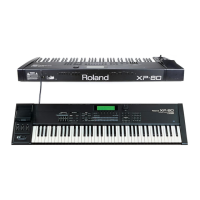As the file selection has not been finalized yet, the song
number and file name will be boxed.
✳ A u mark or d mark will appear at the display upper
left or lower left. This indicates there are more files that
cannot fit the current display window. To view those
files, move the cursor to the bottom file and press [d]
or [INC]. To view the preceding files, move the cursor
to the top file and press [u] or [DEC].
❹ Press [F6] (Select) or [ENTER] to finalize the file selec-
tion.
The File List window will close.
✳ To close the File List window without finalizing the file
selection, press [EXIT].
...........................................................................................................
❚
Loading a file from disk into the
XP-80 – 1 Load
This function loads a song on disk into the internal memory.
As the XP-80 loads MRC Pro songs as well as Standard MIDI
Files and S-MRC format songs, it copes efficiently with dif-
ferent song data. And with MRC Pro songs, a Phrase track or
Pattern can be specified for loading. A complete song can
therefore be created by combining different MRC Pro song
data. Besides songs, you can also load data files or chain files
into internal memory.
✳ Loading a new file will rewrite data currently resident
in memory. To keep existing data, save it to disk before
loading new data.
File Type
Selects the type of file you want to load.
SONG: Loads an MRC Pro song or Standard MIDI File into
internal memory.
TRACK: Loads a specified Phrase track or Pattern extracted
from an MRC Pro song into the Phrase track or Pattern you
specify in internal memory.
S-MRC: Converts an S-MRC format song created on an MC-
50, etc. into an MRC Pro song and loads it into internal
memory.
SOUND: Loads Patches, Performances and Rhythm Sets into
user memory, and System data into system memory.
CHAIN: When the XP-80 sequencer is in chain play mode, a
chain file containing chain play settings will be loaded into
XP-80.
✳ When the XP-80’s sequencer is in chain play mode,
only CHAIN or SOUND can be selected. SOUND can-
not be selected when GM mode is chosen.
✳ When SOUND is selected, the entire data file will be
loaded. If you wish to load a specific Performance,
Patch or Rhythm Set, use the Data Transfer function
(UTILITY/Xfer/Transfer to User).
File Name
Selects the file to be loaded.
If SONG or TRACK is selected for the File Type parameter,
the song name will appear in parentheses ( ).
<Procedure>
❶ Make sure that the Disk Menu display (DISK) is up.
❷ Press [F6] (Menu) to select Menu 1, then [F1] (Load) to
call up the Load display (DISK/Load).
This display can also be called up by moving the cur-
sor to “1 Load” and pressing [ENTER] on the Disk
Menu display (DISK), or pressing the numeric key [1]
then [ENTER].
❸ Move the cursor to “File Type” and select the type of
file to be loaded.
If the File List window is up, you can select the desired file
by pressing a button from [F2] (Song)–[F5] (Sound). This will
also change the file shown in the File List window.
✳ If TRACK has been selected, you’ll choose the Phrase
track or Pattern for extracting and the loading destina-
tion (internal memory) Phrase track or Pattern. You
can also select TRK1–TRK16 by pressing TRACK/
PART[1]–[16]. You can also select PTN001–PTN100 by
pressing [PATTERN] and specifying a Pattern number.
❹ Move the cursor to “File Name” and select the file you
want to load.
To select a file in the File List window, press [F5] (List).
❺ Press [F6] (Execute) to load data.
...........................................................................................................
<Auditioning a Phrase track or Pattern>
With MRC Pro songs, it is possible to extract a specific
Phrase track or Pattern and load it into internal memory.
Here you can audition the Phrase track or Pattern to be
extracted.
Pressing [STOP/PLAY] before executing loading will play
back only the current Phrase track or Pattern.
✳ It may take some time before playback begins.
✳ If the specified Phrase track or Pattern contains mode
settings, the Utility mode will disengage, making it
impossible to continue auditioning from that point.
...........................................................................................................

